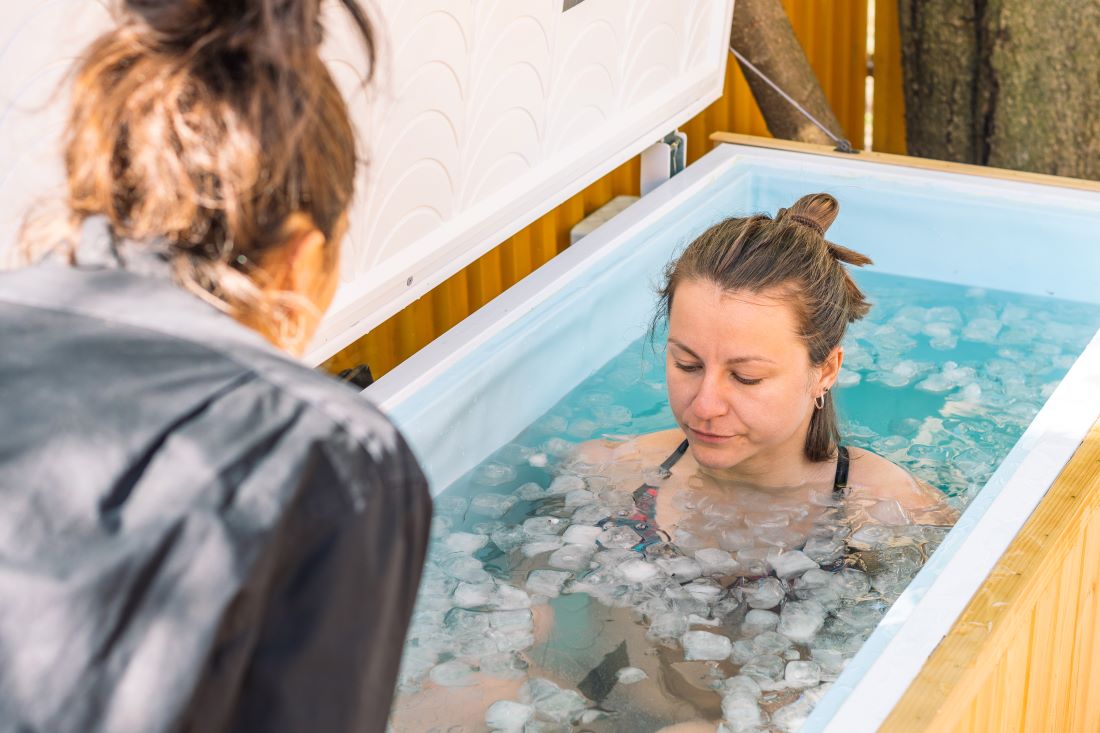
Though they may seem like the newest fitness trend to sweep social media, ice baths have been popular since 3500 BC and are now a part of many people’s post-workout and wellness routines.
So, what is an ice bath? If you’re looking to learn more before taking the plunge, this guide will cover everything you need to know.
What Do Ice Baths Do?
An ice bath involves submerging your body, or parts of it, in cold water for a short period of time.
A popular post-workout practice enjoyed by seasoned sports professionals and fitness aficionados, they’re classified as a type of cold-water therapy (CWT).
Ice baths, like other forms of CWT, such as wild swimming and cryotherapy, are believed to temporarily lower the body’s internal temperature to invigorate particular physiological responses.

Are Ice Baths Good for You?
While the prospect of plunging into cold water may not sound that appealing, many swear by its potential to promote post-workout recovery.
Exposing the body to low temperatures in an ice bath could contribute to reduced inflammation and muscle soreness.
How to Take an Ice Bath
Before taking the plunge for the first time, you may want to consider taking the following measures:
Dress Appropriately
As a beginner, it’s widely recommended to wear breathable clothes in an ice bath. Most people choose a pair of shorts or gym leggings with a long-sleeve t-shirt to offer as much coverage as possible.
However, your attire could also depend on how much of your body you’re planning to submerge. For example, if you’re keeping your shoulders and arms out, you may be content with short sleeves.
You may also want to layer up with a swimsuit or trunks underneath.
Set the Right Temperature
If you’re wondering what temperature an ice bath should be, the optimal range is generally between 10 and 15 degrees Celsius (or 50 to 59 degrees Fahrenheit).
But if you’re new to it, you may prefer to start with slightly warmer water to help build up your tolerance to cooler temperatures.
Submerge Yourself Slowly
How you enter the bath depends on how experienced you are.
If you’re a novice, start by just lowering yourself in very gradually. At first, you may even prefer to sit on the side and just put your feet and legs in.
Take care not to submerge your head – the water shouldn’t come any higher than the tops of your shoulders.
Breathe deeply and evenly as you ease yourself in to allow your body to adjust.
Time Yourself
When considering how long should you stay in an ice bath, it’s widely advised to not exceed the 15-minute mark.
You might wish to build up to this though, as you may find that you can only withstand a few minutes to start with.
Bring a Friend
Some ice bathers prefer to have someone close to help. Simply ask them to wait nearby should you need an extra pair of hands.
Pick the Right Time
While there isn’t an optimal time, it’s largely recommended to have one as soon as you’ve finished a form of physical exercise.
How Often Should You Have an Ice Bath?
Again, there isn’t a conclusive number to aim for.
You may want to begin with having a couple each week and gradually increase the number as you grow accustomed to them.
Recover Properly
When you’re ready to get out, emerge slowly and carefully before sitting down on a nearby chair to allow your body to adjust to the temperature change.
Once sat, dry off with a towel, put on some fresh clothing and wrap yourself in a blanket.
When you’re feeling slightly warmer, you may want to also try some slow, gentle walking or stretching, as this may help your body to heat up sooner.
If you’re wondering how long to wait to shower after an ice bath, don’t be tempted to do so until your body has acclimatised properly.
An ice bath isn’t the only way to support your post-workout recovery. Explore our range of fitness supplements to elevate your exercise regime even further.









